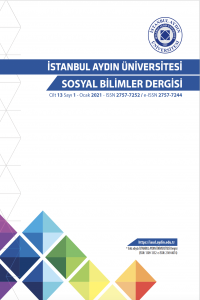SOSYAL VE EKONOMİK GELİŞMİŞLİK AÇISINDAN BOŞANMA HIZI, DOĞURGANLIK HIZI VE SATINALMA GÜCÜ PARİTESİ FARKLILIKLARI
Sosyo-ekonomik bağlamda yapısal olarak geçirdiği devinim neticesinde ailedeki boşanma ve doğurganlık hızları ile satınalma gücü değişmektedir. Bu araştırmada, özellikle son yıllarda küreselleşme, pandemi ve ekonomik çalkantılar neticesinde Türkiye’de illerin sosyo-gelişmişlik düzeyinde ortaya çıkan farklılıkların ortaya konulması amaçlanmıştır. Türkiye İstatistik Kurumu 2009-2021 yılları arası resmî verileri bağlamında illerin sosyo-gelişmişlik düzeylerine göre tek yönlü varyans analizleri (ANOVA) yapılmış, elde edilen bulgular tablolar halinde sunulmuş ve sonuçlar yorumlanmıştır. Araştırmadan elde edilen bulguların genel değerlendirmesi neticesinde üç temel sonuca ulaşılmıştır. Birincisi, illerin sosyo gelişmişlik düzeyi boşanma oranları ile doğrusal anlamda ilintilidir. Sosyo gelişmişlik düzeyi yüksek olan illerden düşük olan illere doğru boşanma hızlarının kademeli düşüşü söz konusu durumu açıklamaktadır. İkincisi, sosyo gelişmişlik düzeyi belirli bir seviyeye kadar doğurganlık hızı üzerinde etkili değilken belirli bir seviyenin altına düşmesi (altıncı düzey illerinin seviyesinin burada temel alınması gerektiği saptanmıştır) doğurganlık hızında anlamlı bir fark yaratmaktadır. Üçüncü olarak da sosyo gelişmişlik düzeyi belirli bir seviyenin üstünde olduğunda (üçüncü grup ve üzeri olanlar) satınalma gücü paritesi anlamlı bir fark meydana getirmektedir. Ayrıca; bu tür analizlerin iller düzeyi yerine illerin sosyo-gelişmişlik düzeyi gibi daha uygun sınıflandırmalara göre yapılmasının daha anlamlı sonuçlar verdiği sonucuna ulaşılmıştır.
Anahtar Kelimeler:
Aile, Boşanma Hızı, Doğurganlık Hızı, Satınalma Gücü Paritesi, Sosyo-Ekonomik Gelişim Düzeyi., Family, Divorce Rate, Fertility Rate, Purchasing Power Parity, Socio-Economic Development Level.
DIFFERENCES IN DIVORCE RATE, FERTILITY RATE, AND PURCHASING POWER PARITY IN TERMS OF SOCIO-ECONOMIC DEVELOPMENT LEVEL
As a result of the structural movement in the socio-economic context, divorce and fertility rates in the family and purchasing power are changing. In this research, it is aimed to reveal the differences that emerged from base provinces in Türkiye as a result of globalization, pandemics, and economic turmoil, especially in recent years. In the context of the official data of the Turkish Statistical Institute between the years 2009-2021, a one-way analysis of variance (ANOVA) was made by the SPSS program according to the socio-development levels of the provinces, the findings were presented in tables and the results were interpreted. As a result of the general evaluation of the findings obtained from the research, three basic conclusions were reached. First, the socio-development level of the provinces is linearly related to the divorce rates. The gradual decrease in divorce rates from provinces with a high socio-development level to provinces with a low socio-development level explains this situation. Secondly, while the socio-development level has no effect on the fertility rate up to a certain level, falling below a certain level (it was determined that the level of the sixth-level provinces should be taken as the basis here) creates a significant difference in the fertility rate. Thirdly, when the socio-development level is above a certain level (those in the third group and above), purchasing power parity creates a significant difference. Moreover; it has been concluded that performing such analyzes according to more appropriate classifications such as the socio-development level of the provinces instead of the province level gives more meaningful results.
Keywords:
Family, Divorce Rate, Fertility Rate, Purchasing Power Parity, Socio-Economic Development Level.,
___
- Özkiraz, A., & Baş, G. İ. (2016). Osmanlıdan Günümüze Türk Toplumunda Aile Yapısı ve Boşanma. Sosyal ve Ekonomik Arastırmalar Dergisi, 18(30), 87.
- Popova, D., & Navicke, J. (2019). The Probability of Poverty for Mothers After Childbirth and Divorce in Europe: The Role of Social Stratification and Tax- Benefit Policies. Social Science Research, 78, 57-70.
- Raftery, E.A. (2006). Quantitative Research Methods, The Sage Handbook of Sociology, 15-39, London, Sage.
- Rais, I. (2021). The impact of COVID-19 pandemic on divorce rates among Indonesian Muslim societies. Indonesian Journal of Islam and Muslim Societ- ies, 11(2), 271-297.
- Raymo, J. M., Fukuda, S., & Iwasawa, M. (2013). Educational Differenc- es in Divorce in Japan. Demographic Research, 8, 177–206. doi:10.4054/ DemRes.2013.28.6.
- Ross, C. E., & Mirowsky, J. (1999). Parental Divorce, Life-Course Disruption and Adult Depression. Journal of Marriage and the Family, 61, 1034-1045.
- Şahbaz, H. (2022). Coğrafi Bir Bakış Açısıyla 2001-2020 Döneminde Türkiye’deki Boşanmalar. Erzurum Teknik Üniversitesi Sosyal Bilimler Enstitüsü Dergisi, (14), 21-58.
- Tabachnick, B. G. & Fidell, L. S. (2013). Using multivariate statistics (6th ed.). New Jersey, Pearson.
- Toth, K., & Kemmelmeier, M. (2009). Divorce Attitudes Around The World: Distinguishing The Impact Of Culture On Evaluations And Attitude Structure. Cross-Cultural Research, 43(3), 280-297.
- Tezcan, S., & Coşkun, Y. (2004). Türkiye’de 20. Yüzyilin Son Çeyreğinde Kadin- larda İlk Evlenme Yaşi Değişimi Ve Günümüz Evlilik Özellikleri. Nüfusbilim Dergisi, 26(1), 15-34.
- Turğut, F. (2017). Tarihsel Süreçte Aile Kurumunun Dönüşümü ve Geleceğine Yönelik Çıkarımlar. Medeniyet ve Toplum Dergisi, 1(1), 93-117.
- Ünal, V., (2013). Geleneksel Geniş Aileden Çekirdek Aileye Geçiş Sürecinde Boşanma Sorunu ve Din. Uluslararası Sosyal Araştırmalar Dergisi, 6(26), 588- 601.
- ISSN: 2757-7252
- Yayın Aralığı: Yılda 4 Sayı
- Başlangıç: 2009
- Yayıncı: İstanbul Aydın Üniversitesi
Sayıdaki Diğer Makaleler
Özlem ÇAĞLAN BİLSEL, Seçkin ÖZMEN
Hatice YALÇIN, Miyase TAŞKIRAN, Aysenur ÖZTÜREN
